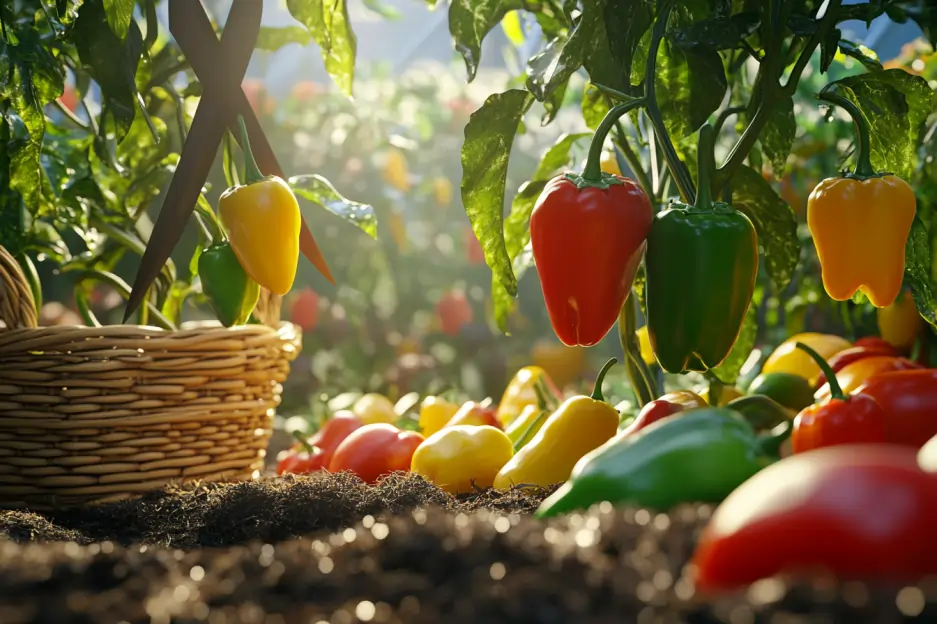Peppers are a versatile and flavorful addition to any garden, ranging from mild, sweet bell peppers to fiery hot habaneros. Whether you’re growing peppers outdoors or indoors, they are a rewarding crop that thrives in various conditions. To get started, choose the right variety for your climate. Proper care—whether you’re cultivating sweet or spicy varieties—will ensure a bountiful harvest. This guide provides expert tips for planting, caring for, and harvesting peppers, along with troubleshooting common issues. Let’s dive into the process of growing peppers successfully!
Why You Should Start Growing Peppers ?
Peppers offer a range of flavors and uses in the kitchen. From sweet, crunchy peppers perfect for salads to spicy varieties that add heat to salsas and hot sauces, there’s a pepper for every taste. Plus, growing your own peppers ensures they are fresher, more flavorful, and richer in vitamins than store-bought varieties.

Choosing the Best Pepper Varieties for Growing ?
When selecting pepper varieties, consider your climate and culinary preferences. Some peppers, like sweet bell peppers, require longer growing seasons, while smaller, thin-walled varieties such as banana peppers or jalapeños ripen faster and are more suited for cooler climates.
- Sweet Peppers: Best for fresh eating, salads, or stuffing. These include bell peppers, which can ripen to red, yellow, orange, or even purple.
- Spicy Peppers: Add heat to your dishes. Varieties like jalapeños, cayenne, or habaneros range from mild to extremely hot.
Use our Pepper Chooser Tool to help you find the perfect variety for your garden!

Step-by-Step Guide to Growing Peppers
1. When to Plant
When it comes to growing peppers, timing is key. Plant your peppers 1-2 weeks after the last frost when daytime temperatures consistently reach 70°F or higher. Start your pepper seedlings indoors about 8 weeks before this date to give them a head start.
For more tips on how to cultivate a productive garden, check out our guide on growing tomatoes.

2. Ideal Growing Conditions
- Sunlight: Peppers need 6-8 hours of direct sunlight per day. Choose a spot with full sun for best results.
- Soil: Use well-drained, nutrient-rich soil. Mix in compost or organic matter to enrich the soil. For in-ground gardens, a pH between 6.2 and 7.0 is ideal.
- Spacing: Plant peppers 18-24 inches apart to allow airflow and growth.
3. Planting in Containers or Raised Beds
Peppers also thrive in containers or raised beds. Use a high-quality potting mix like Miracle-Gro® Performance Organics® All Purpose Container Mix for containers or Raised Bed Mix for raised beds. This ensures excellent drainage and supports healthy root growth.

Watering and Mulching
Keep your pepper plants well-hydrated, aiming for 1-2 inches of water per week, depending on weather conditions. Water at the base of the plant, avoiding wetting the leaves to reduce the risk of disease. To retain moisture and regulate soil temperature, spread mulch, such as straw or chopped leaves, around the plants.
Fertilizing for Bigger Harvests
Peppers are heavy feeders, so provide consistent nutrition throughout the growing season. Incorporate a continuous-release fertilizer into the soil at planting, and reapply as directed. Alternatively, feed with a water-soluble fertilizer every 1-2 weeks to encourage lush growth and higher yields.
For example, using Miracle-Gro® Performance Organics® Plant Nutrition Granules will keep your plants healthy all season long. Simply pull back the mulch, apply the fertilizer, and replace the mulch before watering.

Supporting Your Pepper Plants
Peppers can become top-heavy as they begin to bear fruit. Use stakes or small tomato cages to support your plants and prevent branches from breaking under the weight of the peppers.
Common Issues When Growing Peppers
While peppers are generally low-maintenance, you may encounter a few issues:
- Blossom Drop: In hot climates, large-fruited peppers might drop blossoms during peak summer heat. In cooler areas, choosing small, thin-walled varieties like banana peppers can help maintain productivity.
- Pests: Most peppers resist common pests, but watch out for aphids and root-knot nematodes. Use organic pest control methods like neem oil to protect your plants. For more information on organic pest control methods, check out this guide on how to use neem oil.
- Viral Diseases: If your plants appear frail or stunted, they may be infected by a virus spread by insects. Growing resistant varieties is the best prevention.
If a late spring frost is predicted, cover your plants to protect them from cold damage.

Harvesting and Storing Peppers
Peppers change color as they ripen, moving from green to red, yellow, or orange, depending on the variety. Fully ripened peppers have enhanced flavor and nutritional value.
- How to Harvest: Use pruning shears or a sharp knife to cut peppers from the plant, leaving a small portion of the stem attached. Avoid pulling peppers off by hand to prevent damaging the plant.
- How to Harvest: Use pruning shears or a sharp knife to cut peppers from the plant, leaving a small portion of the stem attached. Avoid pulling peppers off by hand to prevent damaging the plant.
Ripening Indoors
If frost is approaching and your peppers are still green, harvest them and store them in a warm room. Many varieties will continue to ripen indoors. For best results, consume peppers that show signs of color change within 2-3 days.

Handling Hot Peppers Safely
Capsaicin, the compound that gives hot peppers their heat, can irritate your skin and eyes. Follow these tips when handling hot peppers:
- Wear gloves to protect your hands.
- If pepper juice gets in your eyes or on your skin, flush with cold water immediately.
- After handling hot peppers, wash all surfaces, knives, and cutting boards thoroughly.

Quick Tips for Growing Peppers
- Plant after frost: Wait until after the last frost when temperatures are consistently warm.
- Provide sunlight: Ensure plants get 6-8 hours of sunlight daily.
- Water regularly: Water deeply, aiming for 1-2 inches per week.
- Fertilize consistently: Use a continuous-release fertilizer or apply a water-soluble fertilizer every 1-2 weeks.
- Support plants: Use stakes or cages to support plants as they grow.
- Harvest carefully: Use shears or a knife to harvest without damaging the plant.
- Store properly: Store harvested peppers in the fridge or preserve them by drying, freezing, or pickling.

